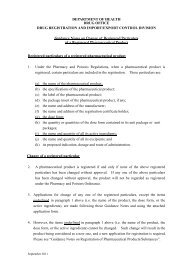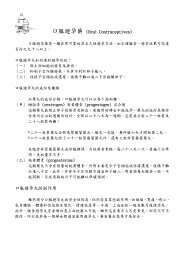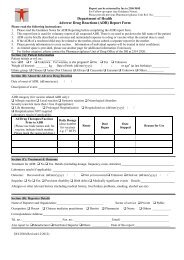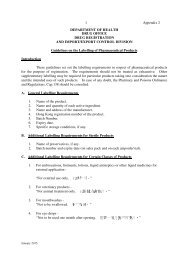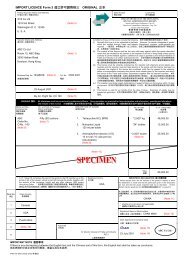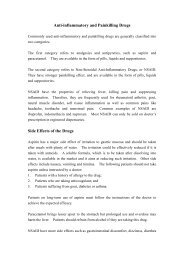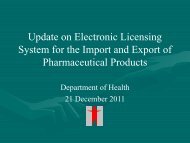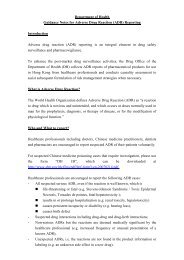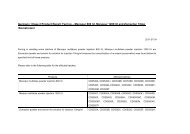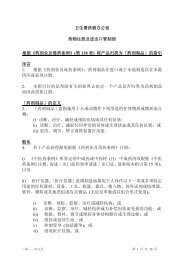Hong Kong Guide to Good Manufacturing Practice for the Secondary ...
Hong Kong Guide to Good Manufacturing Practice for the Secondary ...
Hong Kong Guide to Good Manufacturing Practice for the Secondary ...
Create successful ePaper yourself
Turn your PDF publications into a flip-book with our unique Google optimized e-Paper software.
5. GOOD PRACTICES IN SECONDARY PACKAGING<br />
5.1 The appropriate registered particulars of <strong>the</strong> pharmaceutical products that are subject <strong>to</strong><br />
secondary packaging should be complied with and, where necessary, <strong>the</strong> approval of <strong>the</strong><br />
holder of <strong>the</strong> Certificate of Drug/Product Registration should be sought if <strong>the</strong>re is any<br />
variation <strong>to</strong> <strong>the</strong> registered particulars.<br />
5.2 When setting up a program <strong>for</strong> <strong>the</strong> secondary packaging operations, particular attention<br />
should be given <strong>to</strong> minimizing <strong>the</strong> risk of cross-contamination, mix-ups or substitutions.<br />
The secondary packaging of different products should not be carried out in close<br />
proximity unless <strong>the</strong>re is physical segregation.<br />
5.3 Special care should be taken when using cut-labels and when over-printing is carried out<br />
off-line. Roll-feed labels are preferable <strong>to</strong> cut-labels in helping <strong>to</strong> avoid mix-ups.<br />
5.4 Written procedures should be available <strong>for</strong> <strong>the</strong> handling of any spillage or breakage<br />
involving pharmaceutical products containing highly active substances (e.g. cy<strong>to</strong><strong>to</strong>xics,<br />
steroids, hormones, etc.) or highly sensitising substances (e.g. penicillins,<br />
cephalosporins, etc.).<br />
5.5 All products and materials used <strong>for</strong> secondary packaging operations should be checked<br />
be<strong>for</strong>e use by a designated person <strong>for</strong> quantity, identity and con<strong>for</strong>mity with <strong>the</strong><br />
Packaging Instructions.<br />
5.6 Line clearance checks should be per<strong>for</strong>med prior <strong>to</strong> commencement of each secondary<br />
packaging operation. Steps should be taken <strong>to</strong> ensure that <strong>the</strong> working area, packaging<br />
lines, printing machines and o<strong>the</strong>r equipment are clean and free from any products,<br />
materials or documents previously used, if <strong>the</strong>se are not required <strong>for</strong> <strong>the</strong> current<br />
operation.<br />
5.7 Each batch of product produced must be assigned a unique batch number which may<br />
incorporate <strong>the</strong> original manufacturer’s batch number and a suffix <strong>to</strong> identify each<br />
separate packaging run. Alternative batch numbering systems that provide full<br />
traceability <strong>to</strong> each packaging run may be accepted.<br />
5.8 The correct per<strong>for</strong>mance of any printing operation (<strong>for</strong> example batch number coding<br />
and expiry dating) should be checked and recorded. Attention should be paid <strong>to</strong> printing<br />
by hand which should be re-checked at regular intervals.<br />
5.9 Printed and embossed in<strong>for</strong>mation on packaging materials should be distinct and<br />
resistant <strong>to</strong> fading or erasing.<br />
5.10 On-line control of <strong>the</strong> product during secondary packaging should, where applicable,<br />
include checking <strong>the</strong> following:<br />
a. General appearance of packages.<br />
b. Completeness of packages.<br />
c. Correctness of products and packaging materials used.<br />
d. Correctness of over-printing, e.g. batch number, expiry date.<br />
e. Correctness of supplementary labels applied <strong>to</strong> products.<br />
5.11 Any deviation from instructions or procedures should be avoided as far as possible. If a<br />
deviation occurs, it should be approved in writing by <strong>the</strong> Quality Assurance Officer.<br />
5.12 Any significant or unusual discrepancy observed during reconciliation of <strong>the</strong> amount of<br />
printed packaging materials used and <strong>the</strong> number of units produced should be<br />
investigated and satisfac<strong>to</strong>rily accounted <strong>for</strong> be<strong>for</strong>e release <strong>for</strong> sale or supply.<br />
5.13 Upon completion of a secondary packaging operation, any unused batch-coded<br />
packaging materials should be destroyed and <strong>the</strong>ir destruction recorded. A documented<br />
procedure should be followed if un-coded printed materials are returned <strong>to</strong> s<strong>to</strong>ck.<br />
<strong>Hong</strong> <strong>Kong</strong> <strong>Guide</strong> <strong>to</strong> <strong>Good</strong> <strong>Manufacturing</strong> <strong>Practice</strong> <strong>for</strong> <strong>the</strong> <strong>Secondary</strong> Packaging of Pharmaceutical Products Page 8



